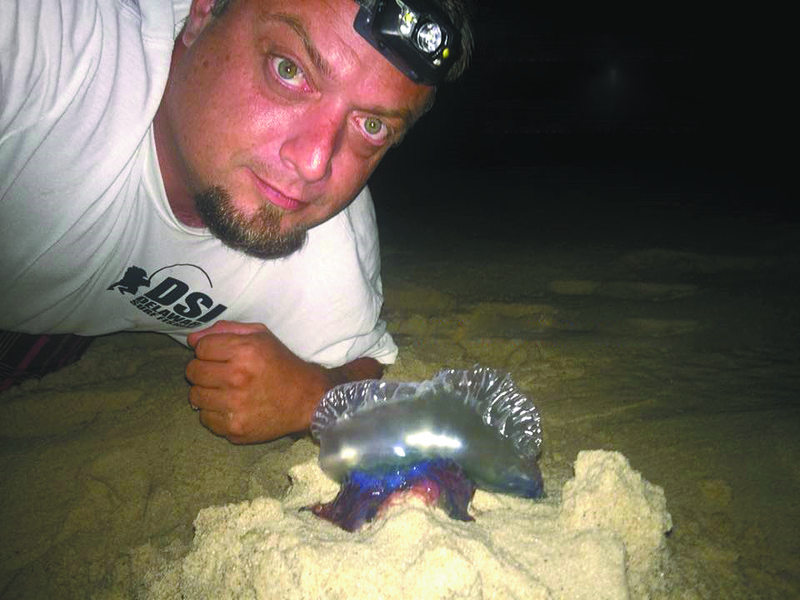Kevin and Amy Baldwin were doing some late-night fishing July 5 when they caught sight of something no one wants to see on Delaware's beaches: a Portuguese man-of-war.
“As soon as I saw it I thought, 'This shouldn't be,'" Kevin said.
The couple said the venomous man-of-war was about the size of a shoe with tentacles hanging from its body.
Kevin and Amy quickly shot photos of the man-of-war at the fishing beach north of the Indian River Inlet bridge, known as Faithful Steward Beach. They also called state officials. Park rangers picked up the dead specimen about 10 a.m., July 6, to dispose of it, Kevin said.
|
• If possible, advise lifeguards or other beach personnel that you have been stung. • Avoid further contact with the Portuguese man-of-war and carefully remove remnants of the tentacles from your skin; do not touch them directly with fingers or any other part of the skin to avoid secondary stinging. Use latex gloves or other protective hand wear. • First rinse with salt water to the affected area (not ocean water). Vinegar, or other folk remedies are not recommended for man-of-war stings because they may increase the delivery of toxins into the affected area. • Follow up with the an application of hot water to the affected area for 15 to 20 minutes, not cold water which tends to worsen the pain. • Finally, antihistamines can help alleviate hypersensitivity to the toxins, which essentially is an allergic response. |
||||
Dozens of man-of-wars have been found along the New Jersey coast this summer, but Rich King of Delaware-surf-fishing.com said this was the first one he's heard of in Delaware.
“I've been waiting for them to wash up on our shores, and one finally did,” King said.
Wayne Kline, chief of Delaware State Parks Enforcement, said he has received two other reports of sightings or stings from Portuguese man-of-wars, one from Fenwick Island, the other from Cape Henlopen State Park.
In talking with other park officials, Kline said, these are the first sightings in at least 15 years.
Anyone stung by a man-of-war tentacle knows it has potent neurotoxins that result in a painful sting.
“The result is often a lashlike welt, swelling, and/or rash-like response in the immediate area of contact,” according to a New Jersey Department of Environmental Protection fact sheet about the Portuguese man-of-war. “Pain is the most immediate result of contact with the man-of-war.”
The fact sheet says the Portuguese man-of-war is not a jellyfish. It is actually hydrozoan, an animal made up of a colony of organisms working together. The brightly-colored bladder can have blue or purple hues, and it floats above water resembling an old warship – hence the name.
Man-of-wars are normally found in tropical waters, but wind currents can sweep them north as far as Canada.
“They are most likely stray individuals that were blown into shore from the Gulf Stream, a warmwater current that comes up from the Gulf of Mexico and carries fish and other animals north along the coast,” New Jersey officials write.
Melissa Steele is a staff writer covering the state Legislature, government and police. Her newspaper career spans more than 30 years and includes working for the Delaware State News, Burlington County Times, The News Journal, Dover Post and Milford Beacon before coming to the Cape Gazette in 2012. Her work has received numerous awards, most notably a Pulitzer Prize-adjudicated investigative piece, and a runner-up for the MDDC James S. Keat Freedom of Information Award.





















































